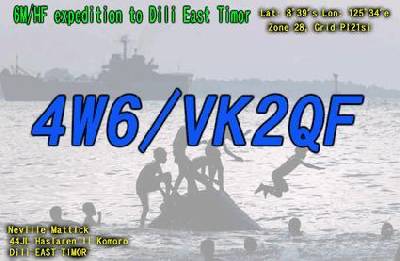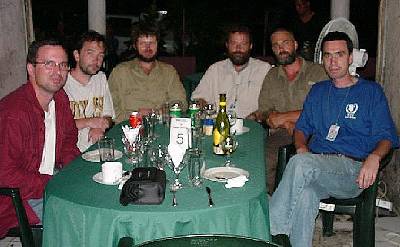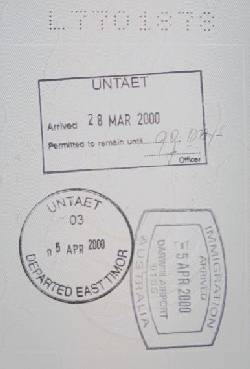The expedition.
Travel was quite new to me, the last aircraft I flew in apart from single-engined Ag planes was an F27 in 1969. This was to be a unique adventure, bearing in mind I have basically been on the same farm now since leaving school in 1975, almost without a break of any kind! Around that time I also started on six metres and April the 6th 1978 was my first QSO on that band, to VK3OT. I went by B737-400 Sydney-Brisbane-Darwin then Embraer 120 to Dili the same day. Return was the reverse except no Brisbane stop over. On reflection the Amateur radio work was not particularly outstanding or exciting, the travel however was.
 Neville's
QSL for his operation from East Timor.
Neville's
QSL for his operation from East Timor.
In total the six-metre band opened six times (naturally) during the expedition. The expected blackouts lasted for 15 hours, mainly due to overdue maintenance to clear the vegetation from the 22kV lines!
Due to freight delays at the docks, my rotator was not available until the evening of the 30th. Masting to hold the six-metre NBS yagi was a problem. The six-element NBS yagi was a heavy beast [13kg] and Ross wanted to move a triangular mast from the Marconi site in town where Thor 4W6MM lives but negotiating through Dili with 5m of steel on the side of a Land Rover would not have been easy!
As a farmer would, I improvised! In the edge of the nearby Comoro river was an abandoned tin building and on top was some 8g mild wire. In the garage at the house were two four-metre palm wood 6x4’s. So without pliers I snapped the wire into 3 lengths and lashed the two 6x4’s together. Converting a used cast iron sticky tape dispenser to work as a hammer I straightened some rusty nails and drove a piece of 1.5 inch square hardwood onto the mast top for the rotator clamp. Watching me perched on the fence top (fortunately this section did not have the usual broken glass security system that the eastern fence top had) some of the locals had a laugh and speculated about what I was up to as we pushed the first six-metre yagi ever in Dili into place!
 All
this was done during the major blackout of the 31st from 0900 to 0410 local
time. So it was good to have AC back and a 1:1 match with the six-metre system.
The band wasn’t open so it was left on keyer mode to KH6 which produced
frustration from both there and H44 with about an hour of unattended beacon
reports when we came back in after tea. The only QSO that night was to YC1EHR,
for me the first on Six.
All
this was done during the major blackout of the 31st from 0900 to 0410 local
time. So it was good to have AC back and a 1:1 match with the six-metre system.
The band wasn’t open so it was left on keyer mode to KH6 which produced
frustration from both there and H44 with about an hour of unattended beacon
reports when we came back in after tea. The only QSO that night was to YC1EHR,
for me the first on Six.
The next morning 50MHz observation began with the usual routine. I checked the band at 0430am, the local day break (2030z). Australian video was scattering weakly on a direct path from 2045z some days, but mostly began at 2200z.
The local morning of 1st, Mark VK8MS was in first on scatter. By the end of his qso FK8CA and 17 VK4 & VK2 worked with VK4BLK the first. Peter H44PT, also claimed a new one at 2247z and VK8’s OT & GF were last for the opening.
The evening of 1st April exposed me to the type of opening that is possible from the tropics. Typically at 1130z no indicators, then weak Malay 48MHz video is audible at 1140z, by 1150z it is strong and the R1 is in! At 1200z the band is open! JA’s everywhere and it’s on, 180 worked plus some of the other Asian stuff such as P29, YB and 9M2.
The morning of 2nd looked promising, VK video was moving the ‘S’ meter from 2151z (0551am local). The only QSO was to Tim, V73AT. VK video peaked at 0000z to S9 but no QSOs and weak ZL video was peaking north of heading at 2229z.
On 3rd, video from Australia was heard at 1950z for a short time and I didn’t stay up then to see what happened as it was too dark. The 3rd saw only weak 46.171 struggle in at 0729z for a short time. A nice opening to KH6SR from 0844z and all the Hawaiian beacons to S5 for 45 minutes too.
An historic dinner was held at the ‘Burnt House Restaurant’ in East Dili this evening. Those attending were Trey 4W/N5KO, Berny 4W/W3UR, Nev 4W6/VK2QF, Ross 4W6UN, Thor 4W6MM and Jose 4W6EB/CT1EEB. The future of Amateur Radio in East Timor, the club station’s equipment that all have brought to donate were discussed at length. This building is a poignant reminder of the burning of East Timor only months before.
 The
entry and exit stamps in Neville's passport: 'United Nations Temporary
Administration in East Timor'.
The
entry and exit stamps in Neville's passport: 'United Nations Temporary
Administration in East Timor'.
The evening opening of 4th saw the band healthy with video by 1145z and a qsy from 10m SSB to EU to work 168 JAs, 9M2, VR2, BV2, BG7, 9V1, YC1 with KH2 and XW2A SWL reports for the opening.
The last morning of operation and the VK video is audible at 2155z. This builds to S9 plus, especially for the Wagga outlet always being the strongest observed. ZL video was in from 2243z but never very strong, however ZL2TPY was heard at 2258z clearly working H44PT! ZL3TY was worked then a difficult and long session to have ZL4AAA hear me on 50.110 cw. Two Sydney stations were worked and one Melbourne station partially heard. In the last dying minutes of my time on air two KH6s worked by 0100z.
Shortly after this, the power was off for the sixth time and did not return prior to my departure for Dili Airport. The antenna, rotator and all cables that I took will remain in Dili and eventually be part of the club station on six metres.
Summary
From 28th March until 5th April 2000, a total of 15 DXCC entities were worked on six metres and a total of 379 QSOs were made on the band.
Breakdown of QSOs for 6m:
YB = 10, VK = 25, FK = 1, H44 = 2, JA = 316, 4W6 = 1, P29 = 2, 9M2 = 4, 9V1 = 3, V73 = 1, KH6 =4, BV2 = 1, BG7 = 2, VR2 = 6, ZL = 2.
The E/W best DX was Hawaii at 8,962km and N/S was Hokkaido at 5,971km.
4W6UN
East Timor now: a snapshot of my observations in a foreign country.
Ross, 4W6UN lives in southern Dili about 6km from the centre of town. Radio-wise it is even worse than my home QTH, a 1,500 hill just to the West\South \East and almost a sea view to the North (fortunately). Alongside is the Comoro, a gravel river which flows at high speed 250m wide when the daily inch or two of rain dumps in the mountains behind.
Everyone has a garden of corn, sweet potato, pumpkins, papaya, banana, mango, custard apple. Large rice fields are the home of the mosquito. These annoying pests carry Dengue, Malaria and Japanese Encephalitis B. The rainforest of East Timor is not a heavy jungle type, but has large grassy areas. Most of the closely settled areas have large stands of highly sought-after coffee under shady protection trees with a canopy up to 80m high.
Just off the coast to the North is the large Timorese Island of Atauro which is beautifully rugged-looking. To the North East is Indonesia and the island of Wetar and to the North West Alor Island, a closer 17km off the coast from the town of Liquica.
The climate at the end of the wet season varies from a nice 22 degrees at night to 33 by day. Just 20 minutes drive south of Dili and the countryside is at 3000 feet, cool and welcoming. Further inland is Mount Ramelau at 9,344 feet and most of the inland is steep ridges with some timber and grass.
Total and sincere thanks to Ross Ballantyne, 4W6UN for his hospitality. Special thanks to Yuu JR2KDN and Nob JF2MBF, JA2TBS, VK8MS, VK3OT, ICOM Australia, VK9NS\NL & Leonie for the kind words of support whilst I was there.
To conserve and share the most, I carried all my food into the country and whilst there caught all my own washing water some of which I drank!
Peace, health and prosperity to the people of East Timor.